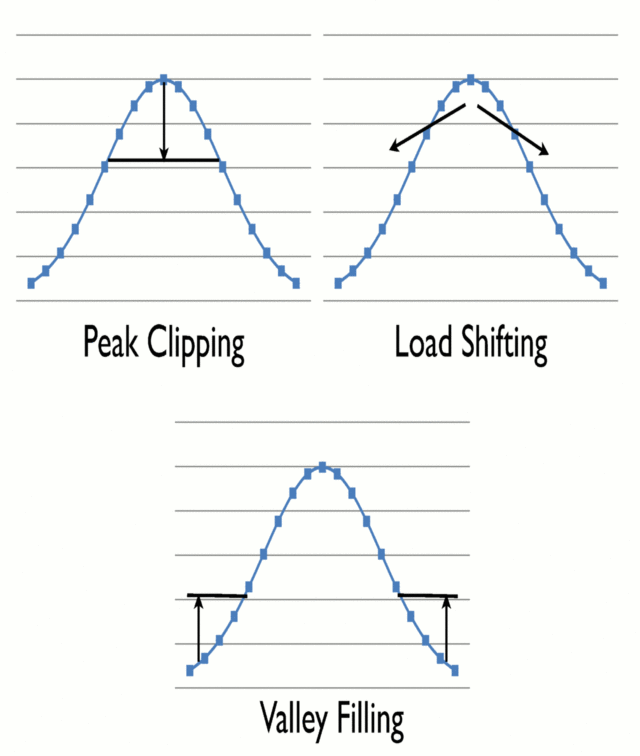New Hampshire Electric Cooperative’s new demand response (DR) program takes advantage of internet-connected water heaters, space heaters and air conditioners in homes and small- to medium-size businesses. NHEC is using this access to members’ most electricity-consuming appliances as part of its bid to incorporate consumer DR into its operations. NHEC is one of the largest consumer-owned electric co-ops in the US.

*NHEC Solar PV Installation
DR programs that utilize new smart grid technologies are becoming more common in utility service territories around the nation, a trend fueled by the need to lower greenhouse gas emissions, incorporate renewable power generation on grids, lower costs and enhance competitiveness. In turn, the gains in energy efficiency realized via DR programs such as NHEC’s account for as much as 50% of the GHG emissions reductions required to meet national and international climate-change goals.
NHEC expects its new Peak Days, Peak Planner and Peak Plus programs to reduce energy costs and add value to the power and energy products and services it provides by lowering or shifting consumer energy consumption from peak to non-peak periods of the day. These individual programs all fall under the umbrella of NHEC’s Go Beyond the Peak! DR initiative.
Demand Response Management via the Cloud
NHEC has turned to Silicon Valley-based AutoGrid and its DROMS (Demand Response Optimization & Management System) to develop and launch its new residential, small- and medium-size business DR programs. A cloud-based ¨Software as a Service¨ (SaaS), DROMS enables utilities to introduce secure, scalable DR program platforms without having to invest in new hardware or software development projects, according to AutoGrid.

Based on open standards, DROMS also gives utilities the flexibility to add to and customize the platform to meet its specific needs. NHEC is using the DR SaaS to manage members’ user experience end-to-end throughout the DR program’s life cycle, AutoGrid highlights in a press release.
“For NHEC, the member experience was the most important consideration for us as we designed and rolled out our demand response programs,” NHEC power resources executive Heather Manypenny elaborated. “The flexibility offered by AutoGrid DROMS is enabling us to manage a wide range of behavioral and automated programs across all our member classes and allows us to offer the right programs to our members not only today but well into the future.¨
The flexibility DROMS provides is evident in the three types of DR NHEC includes in its three new programs: Behavioral Demand Response (BDR), Time of Use (ToU)/Critical Peak Pricing (CPP) and Direct Load Control (DLC).
Behavioral, Time of Use/Critical Peak Pricing and Direct Load Control Demand Response

*Credit: Stanford University
NHEC’s Peak Days takes advantage of BDR to notify members when the electricity co-op expects it will need to shed load and encourages them to lower energy consumption in advance of such events. In contrast, Peak Planner is based on ToU/CPP DR. Member participants agree to reduce their energy use during DR events. In return, their electricity charges are reduced and they’re given bill credits.
Granting NHEC a greater degree of access to connected devices in homes and businesses, Peak Plus is based on DLC. The program allows NHEC to access internet-connected water heaters, space heaters and air conditioners in member participants homes and businesses to lower energy consumption during DR events.
Individually and collectively, the three new DR programs enable NHEC to reduce capacity and transmission charges, which lower its overall wholesale power and delivery cost, according to the press release.
NHEC members can enroll in, monitor and manage their participation in the DR programs and events using a branded NHEC online consumer portal interface developed using AutoGrid’s DROMS. Other key DROMS features NHEC is using include:
- Streamlined device provisioning APIs and flow: AutoGrid DROMS enables a streamlined device provisioning flow where the field services team can have an installer come on-site to install the load control device and easily provision it in the DR program through a mobile app.
- Personalized customer engagement tools: NHEC uses AutoGrid DROMS to communicate with its members and their devices using highly personalized communication tools. In addition, with AutoGrid’s built-in big data analytics, NHEC can determine which members to reach out for each DR program, lowering their marketing costs to increase participation.
- Integrated customer analytics: DROMS supports behavioral DR, dynamic pricing programs as well as fully automated DR programs, allowing NHEC to manage all its programs from a single, unified dashboard. Built-in customer analytics also help NHEC develop programs that meet the needs of its members.
- Responsive customer feedback: AutoGrid’s built-in big data analytics capabilities perform measurement and verification analysis on each individual member’s event response as soon as the interval usage data becomes available from NHEC’s smart meter system and delivers this information back to the member in a timely manner.
“NHEC’s launch of these three new demand response programs shows how utilities can use the energy internet to lower their costs and deeply engage with their customers,” AutoGrid CEO Dr. Amit Narayan explained. “We are proud to be partnering with NHEC as they demonstrate how the energy internet can make our energy system cleaner, more affordable and more reliable.”
